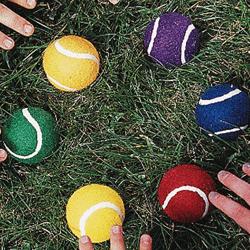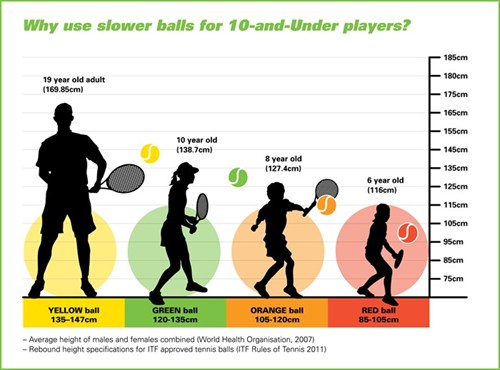Why are there different Colors and Numbers on a Tennis Balls
A tennis ball is a ball that has a standard size of 2.63 inches (6.7 cm) in diameter and is covered with a fibrous felt that directs its aerodynamic properties. While tennis balls are mostly available in optic yellow color, they are actually available in different colors. In addition to this fact, tennis balls also contain numbers marked on each of them. What do the differences in colors and numbers means?
Call us +65-8368-7277 or fill in the Form~we will help you arrange a Tennis coach
Tennis Balls: Colors
 The International Tennis Federation launched the “Play and Stay” campaign in 2011. The Play and Stay campaign intends to encourage more people to start playing tennis worldwide. It introduces three more types of balls aside from the typical optic yellow balls used by adults age 19 and above.
The International Tennis Federation launched the “Play and Stay” campaign in 2011. The Play and Stay campaign intends to encourage more people to start playing tennis worldwide. It introduces three more types of balls aside from the typical optic yellow balls used by adults age 19 and above.
- Stage 3 or red tennis balls are for starters age 5 to 8 years. Red balls have two sub-categories: standard construction or cut/molded foam.
- Stage 2 or orange tennis balls are reserved to kids age 8 to 10 years.
- Stage 1 or green tennis balls are ought to be used by players age 9 to 10 years old. The slowest ball is red, followed by orange, then green and finally, the yellow ball.
- Other colors of tennis balls, such as white, black, pink, blue, etc. may be used depending on your personal preference.
Below are a figure and a table from ITF that shows the properties of each type of tennis ball based on color/stage.
| Standard Construction | Foam Construction | |||
| Stage 1 (green) | Stage 2 (orange) | Stage 3 (red) | Stage 3 (red) | |
| Size | 6.30-6.86 cm (2.48-2.70 inches) |
6.00-6.86 cm (2.36-2.70 inches) |
7.00-8.00 cm (2.76-3.15 inches) |
8.00-9.00 cm (3.15-3.54 inches) |
| Mass | 47.0-51.5 grams | 36.0-46.9 grams | 36.0-49.0 grams | 25.0-43.0 grams |
| Rebound height | 120-135 cm (47-53 inches) |
105-120 cm (41-47 inches) |
90-105 cm (35-41 inches) |
85-105 cm (33-41 inches) |
| Forward deformation | 0.80-1.05 cm (0.315-0.413 inches) |
1.40–1.65 cm (0.551-0.650 inches) |
——- | ——- |
Tennis Balls: Numbers
A common myth among players is that the printed numbers on the tennis balls indicate their bounciness. However, there is neither a special code nor a meaning related to these numbers. All tennis balls are the same within their brand. For example, all Wilson tennis balls have the same properties whether the printed number on them are1, 2, 3 or 4. The same goes for Dunlop, Penn, and other brands.
So why is there a printed number on each tennis ball? The answer is for the purpose of identification. When playing on a court, you will definitely experience your tennis ball rolling, bouncing (or flying for beginners) to the court next to you. When you say “Penn 4!” to the people playing on the next court, they will be able to return the right tennis ball that you own. You don’t want to get an old and filthy tennis ball instead of your own new ball, do you? So, before you start playing, check out the number of the ball/s used by the players next to your court, so you can use a ball with a different number on it.
Call us +65-8368-7277 or fill in the Form



